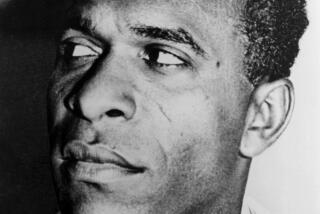BOOK REVIEW : Biography Follows the Path of a Philosopher to His Enlightenment : ENCOUNTER ON THE NARROW RIDGE; A Life of Martin Buber <i> by Maurice Friedman</i> , Paragon House $31.95, 496 pages
- Share via
On the very first page of Maurice Friedman’s new biography of Martin Buber, the author cuts to the flesh and bone of a man who is revered as one of the sublime intellects of the 20th Century. Buber’s magnificent beard, which gave him the daunting appearance of a Hasidic rabbi or an Old Testament prophet, was actually intended as a kind of camouflage.
“The real reason for Buber’s beard,” Friedman reveals in “Encounter on the Narrow Ridge,” “was that the doctor had to deliver him by means of forceps, and he thereby received an injury on the right side of his mouth, which produced a disfigurement in the otherwise exceptionally handsome youth.”
The opening passage tells us something important about Friedman’s approach to the life and work of Martin Buber.
Friedman, a professor at San Diego State University, is the author of a definitive three-volume study of Buber, and he writes with authority and affection about Buber’s work as an interpreter of Hasidism and mysticism, an advocate of Zionism, an existential philosopher who bestowed “I and Thou” on a troubled world.
What’s more, Friedman cannot resist the temptation to drop the first-person pronoun into the narrative, thus reminding us that he was Buber’s friend and collaborator as well as his biographer.
But Friedman is no hagiographer--he insists on placing Buber’s ideas in the here-and-now, and he shows us how the real man came to those ideas in the first place.
As a young child, Buber was literally abandoned by his mother and raised by doting grandparents who encouraged the flowering of his precocious intellect. For “this precocious Wunderkind ,” as Friedman puts it, the simple act of stroking the neck of a horse was “a great, deeply stirring happening,” because the young Buber sensed “the immense otherness of the Other.” And yet the same boy was once moved by a more playful spirit to shove an over-talkative French tutor into a fishpond.
Born in Vienna in 1873, Buber emerged from a Jewish community that regarded itself as legitimate inheritors of a lofty German civilization; to describe something as “really Jewish,” Friedman writes, “was a form of disparagement.”
Buber married a non-Jewish woman, who later converted to Judaism. At the same time, Buber sought out and celebrated the mystical traditions of Hasidism--the ecstatic religious movement of the shtetls of Eastern Europe and Russia--as “the true bearer of the Jewish formative principle, the unifier of life and the spirit . . . the creator of a community of love and righteousness.”
Friedman points out, too, that Buber enjoyed the leisure and solitude to immerse himself in the world of ideas because of a comfortable income from his father’s estate and the willingness of his wife to insulate him from the burdens (and even the noise) of children and housekeeping and child-rearing. On at least one occasion, Friedman reports, he descended from his study, where he was “given to hours of mystic ecstasy,” and administered a beating to his unruly daughter.
But Buber was not only a man of ideas, Friedman insists. Buber played an active and sometimes contentious role in the intellectual and cultural politics of the West during its most tumultuous and dangerous years. Buber feuded with Theodor Herzl and later with Ben Gurion; he once rejected a manuscript submitted by Franz Kafka; he issued broadsides against Jung, Heidegger, Sartre--and he was the target of a broadside from the pen of Gershom Scholem.
Lest the reader think that Friedman is the Kitty Kelley of existential philosophy, I hasten to point out that “Encounter on the Narrow Ridge” is, above all, an intimate study of Buber’s philosophy--and a remarkably lucid and accessible one at that. It’s a book that provides not only a superb introduction to Buber’s life and work but almost a short course of instruction in the practice of “I and Thou” as a philosophical method.
The very title of Friedman’s book echoes one of Buber’s signature phrases: “a narrow rocky ridge between the gulfs,” as Buber once wrote to describe his path through the world, “where there is no sureness of expressible knowledge but the certainty of meeting what remains undisclosed.”
Friedman sees in the phrase “a genuine third alternative to the insistent either-or’s of our age.” And “Encounter” is Friedman’s effort to show us the light that beckoned Buber forward on that treacherous path, a light that illuminates every page of his earnest and honest book.
Next: Richard Eder reviews “What Was Mine” by Ann Beattie (Random House).
More to Read
Sign up for our Book Club newsletter
Get the latest news, events and more from the Los Angeles Times Book Club, and help us get L.A. reading and talking.
You may occasionally receive promotional content from the Los Angeles Times.








